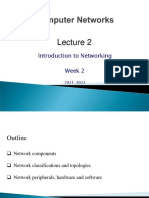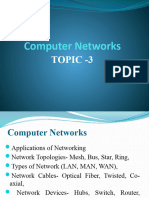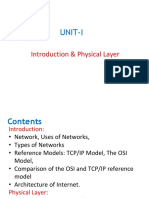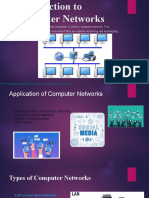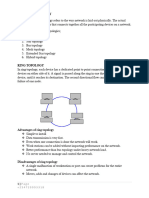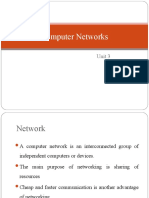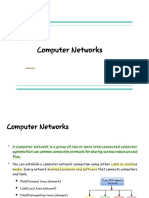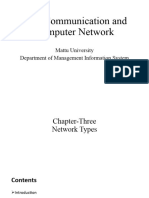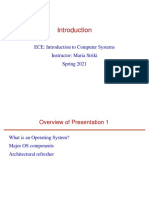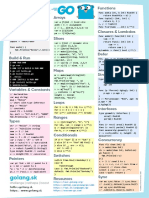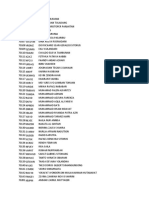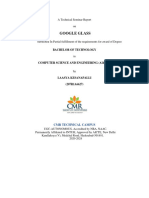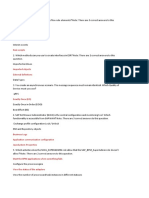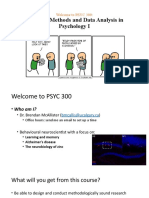UNIT-I Notes: Computer Networks (JNTUH R22 - CS502PC)
🏢 1. Introduction to Computer Networks
A computer network is a system in which multiple computing devices are connected to share information
and resources such as files, printers, internet, etc.
✅ Key Purposes:
• Communication (email, chat, calls)
• Sharing of resources (files, printers)
• Remote access and cloud services
• Centralized data management
📆 Real-Life Examples:
• Using WhatsApp or Zoom for communication
• Accessing Google Drive from different devices
• Office LANs that allow shared printing and storage
👍 Advantages:
• Resource sharing (hardware, software, internet)
• Better communication and collaboration
• Centralized data management
• Remote access
👎 Disadvantages:
• Security risks (e.g., data breaches)
• Setup and maintenance cost
• Network failure affects multiple systems
🧠 Where Used:
• Educational institutes, offices, hospitals, e-commerce platforms
🚀 2. Types of Networks
Type Full Form Coverage Area Example
Few meters (around a Bluetooth between phone &
PAN Personal Area Network
person) headset
1
� Type Full Form Coverage Area Example
Within a building or
LAN Local Area Network Office or school network
campus
Metropolitan Area
MAN City or town Cable TV network, metro Wi-Fi
Network
WAN Wide Area Network Country or continent The Internet
WLAN Wireless LAN Building-wide wireless Wi-Fi at home or office
📊 Visual Hierarchy Diagram
PAN < LAN < WLAN < MAN < WAN
🖼️ Reference Diagram (Online):
✅ Advantages & Uses:
• PAN: Easy to use, low-cost — used in Bluetooth or personal gadgets.
• LAN: High speed and secure — used in schools, offices.
• MAN: Good for city-wide access — used in universities, city Wi-Fi.
• WAN: Covers large areas — used by ISPs, banks, multinational companies.
• WLAN: Wireless and flexible — used in homes, cafés, airports.
👎 Disadvantages:
• PAN: Short range
• LAN: Limited to small area
• MAN: Setup cost is high
• WAN: Complex setup and maintenance
• WLAN: Less secure than wired
🔌 3. Network Topologies
A topology is the layout or structure of how devices are connected in a network.
👎 Common Topologies:
1. Bus Topology
2. All devices connected to a single central cable (the bus)
3. ✅ Easy to install and cost-effective
4. ❌ Cable failure brings down the entire network
2
� 5. 📍 Used in: Small networks or temporary setups
6. Star Topology
7. All devices connect to a central hub/switch
8. ✅ Easy fault detection and management
9. ❌ Hub failure affects entire network
10. 📍 Used in: Home networks, offices, labs
11. Ring Topology
12. Each device connects to two others, forming a ring
13. ✅ Predictable data flow and performance
14. ❌ A single break can disrupt the entire network
15. 📍 Used in: Older LANs, token ring networks
16. Mesh Topology
17. Every device connects to every other device
18. ✅ High redundancy and reliability
19. ❌ Expensive and complex to install
20. 📍 Used in: Military, financial institutions
21. Tree Topology
22. Hierarchical combination of star and bus
23. ✅ Scalable and easy to expand
24. ❌ Backbone failure affects communication
25. 📍 Used in: Large enterprise networks
26. Hybrid Topology
27. Combination of multiple topologies
28. ✅ Flexible, reliable, and customizable
29. ❌ Expensive to design and implement
30. 📍 Used in: Large data centers, ISPs
🖼️ Reference Topology Diagrams:
3
�🧠 Quick Comparison Table
Topology Advantage Disadvantage Used In
Temporary small
Bus Simple & low-cost Backbone failure affects all
networks
Easy to manage & isolate
Star Hub failure breaks network Home/office networks
issues
One break affects entire
Ring Predictable flow Token ring LANs
network
Mesh High reliability Costly and complex Critical sectors (military)
Backbone failure is a weak
Tree Hierarchical, scalable Large enterprises
point
Combines strengths of Design is complex and
Hybrid Data centers, ISPs
topologies expensive
✅ Tips for GATE & JNTUH Exams
• Understand the advantages/disadvantages of each topology.
• Know real-world use cases (e.g., Star in homes, Mesh in military).
• Expect MCQs and labeled diagrams.
• Memorize acronyms like PAN, LAN, MAN, WAN.
Let me know if you'd like a downloadable PDF or if we should continue with the next topic: Transmission
Media.



















